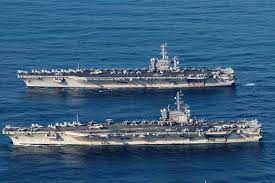Two US aircraft carrier groups have entered the disputed South China Sea for training, according to the Department of Defense, in an effort to reassure allies and display resolve to “fight malign influence,” according to a senior commander.
The contested waterway is one of several points of contention between the US and China, which claims a big part of the waters and has constructed military bases on manmade islands there.
To Beijing’s chagrin, US Navy ships often travel near to these islands to test Chinese sovereignty claims.
The two US Navy Carrier Strike Groups, led by their flagships, the USS Carl Vinson and USS Abraham Lincoln, began operations in the South China Sea on Sunday, according to the US Department of Defense.
To improve combat preparedness, the carrier groups will conduct drills such as anti-submarine warfare operations, air warfare operations, and maritime interdiction operations, according to a release.
The training would be performed in international waters in compliance with international law, according to the Department of Defense, which did not provide further information.
It quoted Rear Admiral J.T. Anderson, commander of the strike group led by the USS Abraham Lincoln, as saying, “Operations like these allow us to improve our combat credible capability, reassure our allies and partners, and demonstrate our resolve as a Navy to ensure regional stability and counter malign influence.”
The US Military said both carrier groups were exercising with Japan’s navy in the Philippine Sea on Sunday, an area that covers waterways to the east of Taiwan.
The announcement of the US operations comes as Taiwan reports the latest major entry by China’s air force into its air defense identification zone in an area near the Taiwan-controlled Pratas Islands in the northern South China Sea.
China has yet to respond but has repeatedly stated that such missions are necessary to preserve China’s sovereignty and prevent outside meddling in its claims to Taiwan.
Taiwan also claims sections of the South China Sea, which is spanned by critical shipping lanes and has gas deposits and rich fishing grounds. Vietnam, Malaysia, Brunei, and the Philippines also claim parts of the sea.

















